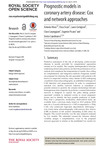Prognostic models in coronary artery disease
| dc.contributor.author | Mora, Antonio | en_US |
| dc.contributor.author | Sicari, Rosa | en_US |
| dc.contributor.author | Cortigiani, Lauro | en_US |
| dc.date.accessioned | 2016-07-18T06:49:11Z | |
| dc.date.available | 2016-07-18T06:49:11Z | |
| dc.date.issued | 2015 | en_US |
| dc.identifier.other | HPU4160449 | en_US |
| dc.identifier.uri | https://lib.hpu.edu.vn/handle/123456789/22293 | |
| dc.description.abstract | Predictive assessment of the risk of developing cardiovascular diseases is usually provided by computational approaches centred on Cox models. The complex interdependence structure underlying clinical data patterns can limit the performance of Cox analysis and complicate the interpretation of results, thus calling for complementary and integrative methods. Prognostic models are proposed for studying the risk associated with patients with known or suspected coronary artery disease (CAD) undergoing vasodilator stress echocardiography, an established technique for CAD detection and prognostication. | en_US |
| dc.format.extent | 13 p. | en_US |
| dc.format.mimetype | application/pdf | |
| dc.language.iso | en | en_US |
| dc.subject | Biology | en_US |
| dc.subject | Biocomplexity | en_US |
| dc.subject | Biomathematics | en_US |
| dc.subject | Medical physics | en_US |
| dc.subject | Coronary artery disease | en_US |
| dc.subject | Coxmodels | en_US |
| dc.subject | Mutual information network | en_US |
| dc.title | Prognostic models in coronary artery disease | en_US |
| dc.type | Article | en_US |
| dc.size | 1.19MB | en_US |
| dc.department | Education | en_US |
Files in this item
This item appears in the following Collection(s)
-
Education [806]

